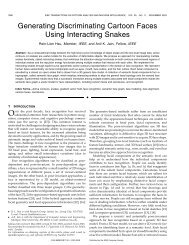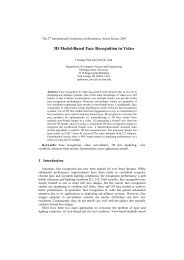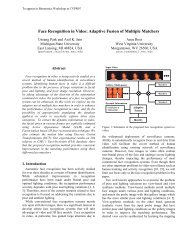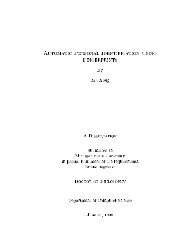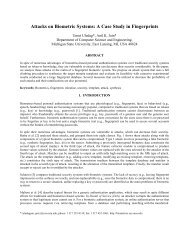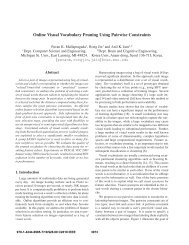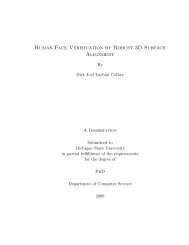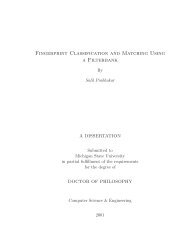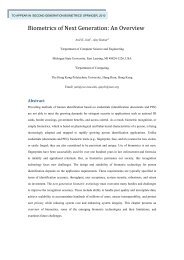Face Detection and Modeling for Recognition - Biometrics Research ...
Face Detection and Modeling for Recognition - Biometrics Research ...
Face Detection and Modeling for Recognition - Biometrics Research ...
You also want an ePaper? Increase the reach of your titles
YUMPU automatically turns print PDFs into web optimized ePapers that Google loves.
shows examples of mouth energies. For the nose component, its GVF is usually weak,<br />
<strong>and</strong> it is difficult to construct an energy map <strong>for</strong> nose. Hence, <strong>for</strong> the nose, we utilize<br />
Tsai <strong>and</strong> Shah’s shape-from-shading (SFS) algorithm [179] to generate a boundary<br />
energy <strong>for</strong> augmenting the GVF <strong>for</strong> the nose component. The illumination direction<br />
used in the SFS algorithm is estimated from the average gradient fields of a face<br />
image [180] within a facial region. Figures 5.11(d) <strong>and</strong> 5.11(e) show examples of nose<br />
boundary energies in a 2D grayscale image <strong>and</strong> a 3D mesh plot, respectively.<br />
5.3.2 Parametric Active Contours<br />
Once we obtain the attraction <strong>for</strong>ce, we can make use of the implicit finite differential<br />
method [77], [127] <strong>and</strong> the iteratively updated repulsion <strong>for</strong>ce to de<strong>for</strong>m the snakes.<br />
The stopping criteria is based on the iterative movement of each snake. Figure 5.12(a)<br />
shows the initial interacting snakes, Fig. 5.12(b) shows snake de<strong>for</strong>mation without the<br />
eyebrow snakes, <strong>and</strong> Fig. 5.12(c) shows finely aligned snakes. Component matching<br />
scores in Eq. (5.4) are then updated based on the line <strong>and</strong> region integrals of boundary<br />
<strong>and</strong> component energies, respectively. We discuss another approach <strong>for</strong> de<strong>for</strong>ming the<br />
interacting snakes based on geodesic active contours <strong>and</strong> level-set functions in Section<br />
5.3.3.<br />
5.3.3 Geodesic Active Contours<br />
As implicit contours, geodesic snakes [181], which employ level-sets functions [182]<br />
are designed <strong>for</strong> extracting complex geometry. We initialize a level-set function using<br />
127



